The Brussels Griffon seemed to have left the pages of fairy tales about good housewives! This adorable and slightly awkward bearded man will easily win the love of all family members.
The Brussels Griffon is an ornamental dog breed. Seeing these kids involuntarily arises an association with Hercule Poirot – the hero of A. Christie’s novels. First, both the legendary detective and the Griffons are united by a common homeland – Belgium. Secondly, animals are notable for the same funny “mustache” as Monsieur Poirot. The Brussels Griffons are distinguished by their cheerful and good-natured nature – the universal key to the hearts of most people. These dogs have an inquisitive and lively mind, do not like to sit in one place, and always follow the owner on the heels. Surround the brisk kid with care and attention, and he will become your most devoted friend you can only dream of!
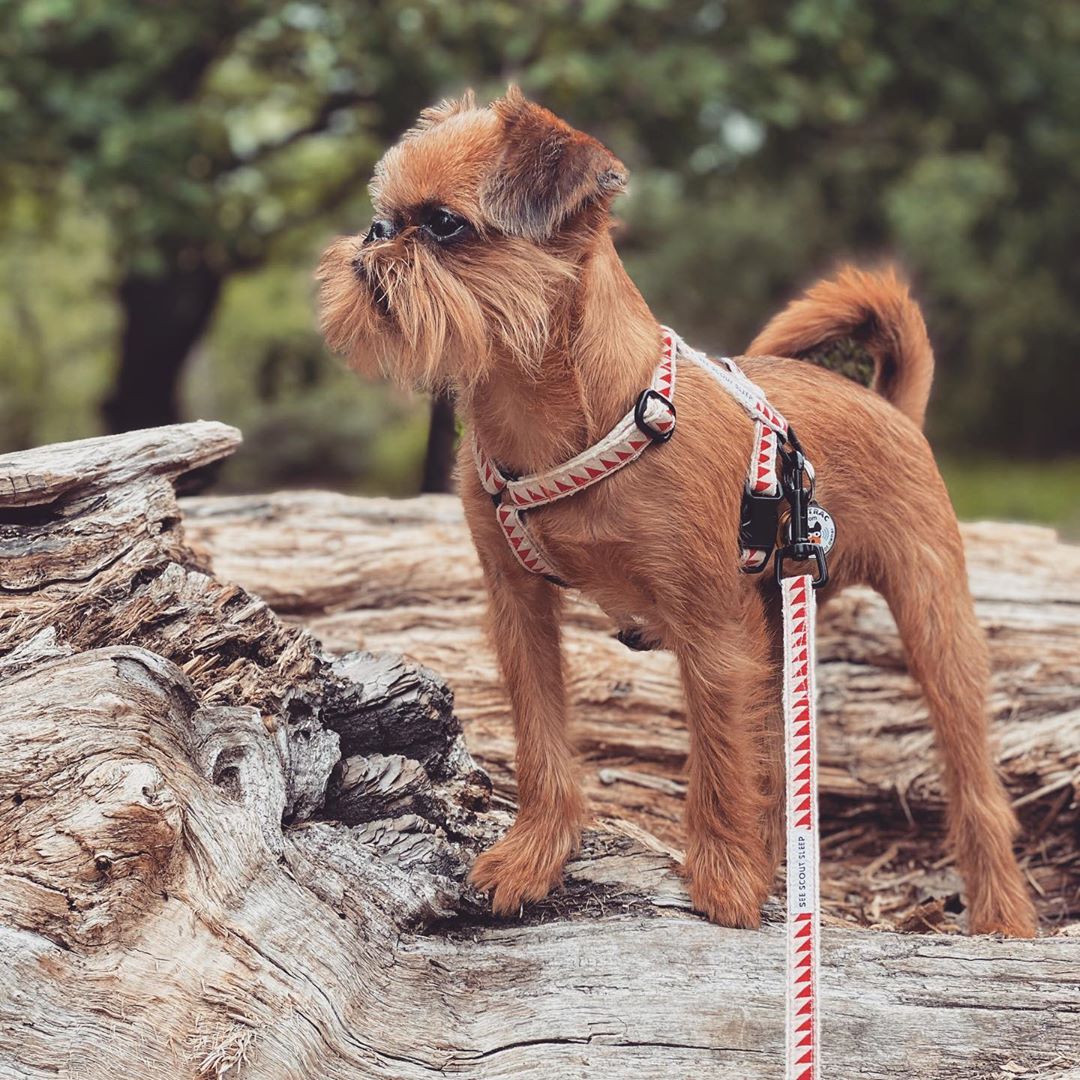
Brussels griffons appeared in Belgium about two centuries ago, although indirect references to the breed date back to the first half of the 15th century. So, in the “Portrait of the Arnolfini couple” by the early Dutch painter Jan van Eyck, a small shaggy dog is depicted, outwardly reminiscent of a Brussels griffon. The similarity of the animal with the modern representative of the breed can be traced in a later painting by the German artist Johann Zoffani. On it, the children of the British King George III play with dogs of a light beige color, similar to griffons.
Contrary to popular belief, the name of the breed did not come from a mythological creature with the head of an eagle and the body of a lion. The word “griffon” is of French origin and translates as “wire-haired”.
The favorable climatic conditions of Belgium obliged its inhabitants to actively engage in agriculture. Wild rodents, distinguished by their amazing gluttony, became frequent visitors to the barns where grain was stored. After a dozen of their barbaric raids, the Belgians could lose their crops before the onset of the winter cold. For successful pest control, a new breed was bred – small shaggy dogs that easily penetrated hard-to-reach places and expelled intruders. Outwardly, they differed from modern animals, but the similarities were obvious.
It is worth noting that the breeding program has become quite fruitful, giving the world three varieties of griffons:
- Belgian – direct descendants of the Affenpinschers;
- Brussels – a cross between Affenpinschers and Cavalier King Charles Spaniels;
- Brabant (Petit Brabancon) – the result of mating Cavalier King Charles Spaniels and pugs.
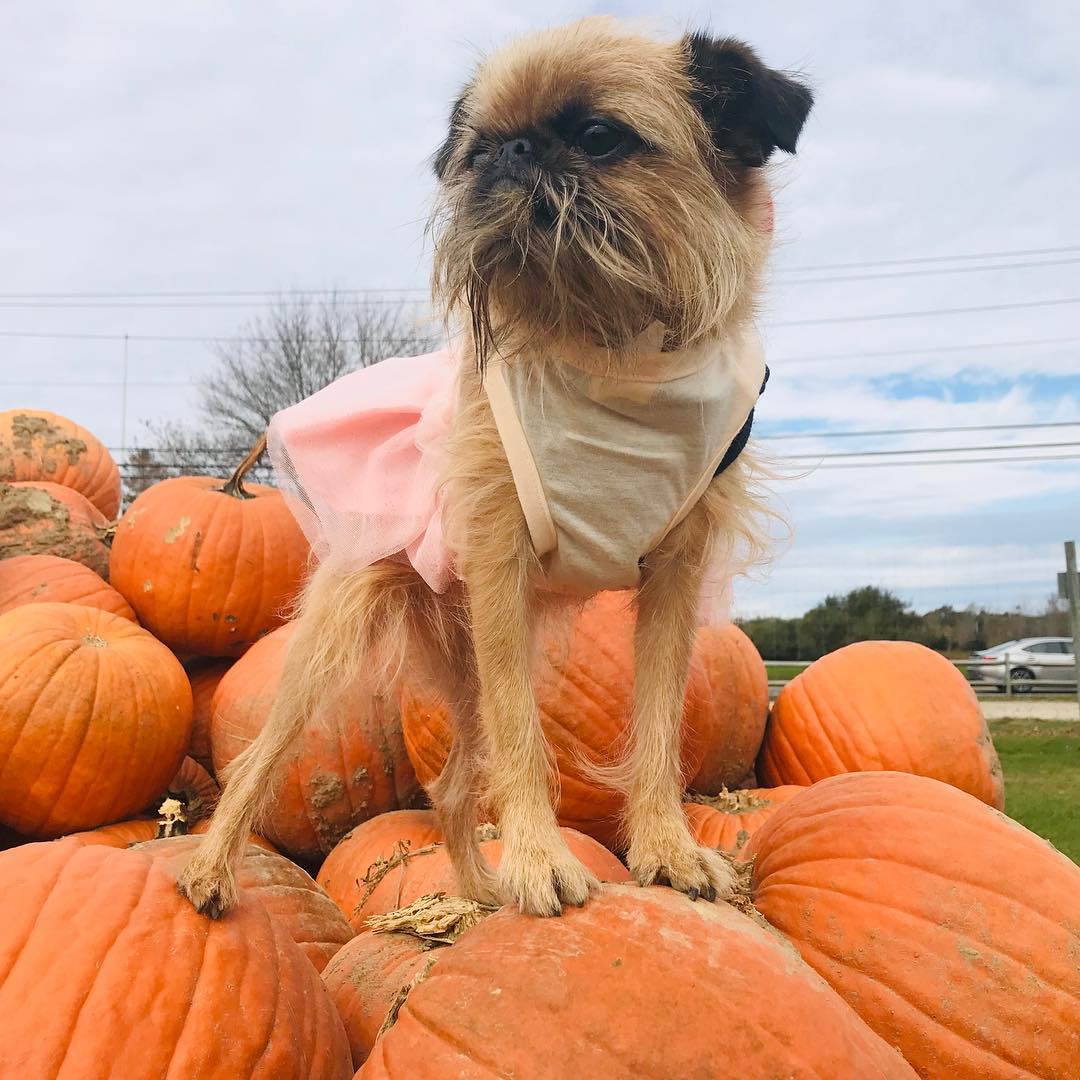
Breeders allow the crossing of three lines with each other. Adult dogs differ only in color and coat type. This is indirectly confirmed by the cases of the birth of representatives of all types of griffons within the same litter.
The fate of little rat-catchers changed dramatically in the second half of the 19th century. Then the griffons attracted the attention of representatives of the nobility. Even the Belgian queen Maria Henrietta admired these dogs. She supported animal breeding and was instrumental in the spread of the breed throughout Europe. Increasingly, noble ladies accompanied by griffons appeared at dinners and balls. Some also used these dogs to guard the carriages: the sonorous barking of the kids immediately attracted attention.
A well-known story with a sad ending is connected with the Brussels Griffons. So, Queen Draga of Serbia was obsessed with the idea of poisoning, so before each meal, she shared a portion of food with her pet. Once, after another bite, the Griffon fell to the floor, dead. The queen’s suspicions were confirmed, but at the same time, she lost her faithful pet.
Brussels griffons did not have a pretty appearance. Their popularity was due to the enthusiasm of the owners, who appeared at various shows and exhibitions with their shaggy pets. The first appearance of the griffons took place in 1880 at an exhibition organized in Brussels. Noticing the public’s interest in the charming “bearded men”, dog lovers united and in 1882 founded the Royal Society of St. Hubert. Soon, its members began to maintain a studbook for the breed, which at that time had a different name – the small Belgian wire-haired terrier.
Such an active strategy was crowned with success: already in 1904, the first breed standard was adopted. Six years later, the Brussels Griffons were entered into the official register of the American Kennel Club (AKC). In 1920, the Orleans Volcano kennel, owned by Miss Ionides, numbered about 40 representatives of the breed. Most of the dogs were brought from France and Belgium. Ten years later, the woman acquired new griffons from the Nunsoe kennel. With the beginning of the military events of the 20th century, Ionides took care of the export of her wards to the UK.
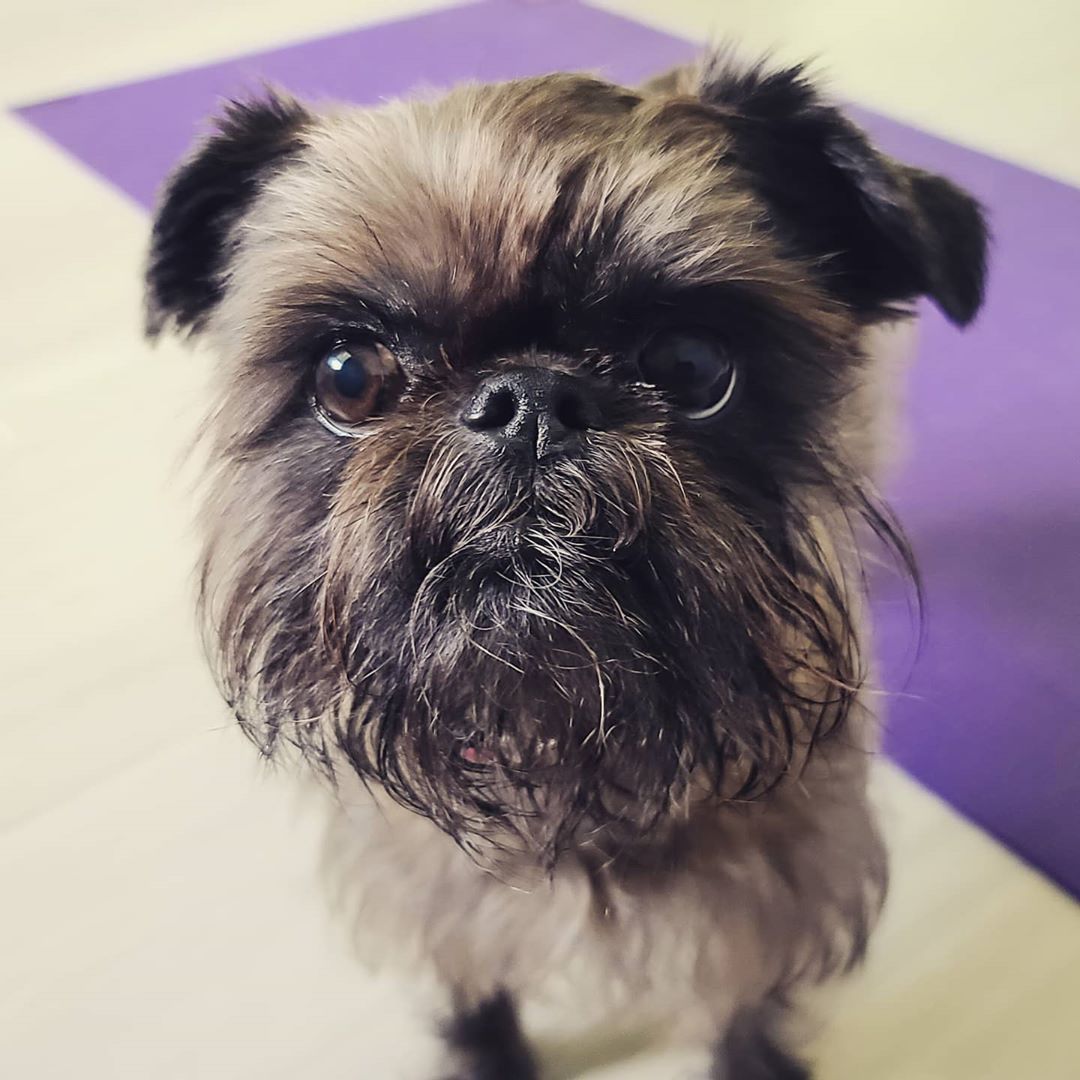
In 1926, the first alarm sounded: representatives of the breed were less and less exported from the territory of Belgium. After the end of World War II, the number of dogs was completely reduced. Mostly they lived in the United States and Great Britain, but at home, they were much less common. 1945 saw the birth of the first American breed association. 11 years later, the Brussels Griffons were recognized by members of the United Kennel Club (UKC). In 1963, breeders finalized the old standard. It is this version that is valid to this day.
Despite the efforts of dog breeders, the breed remained small in number. So, during 1993, the herd book of France registered only 25 cases of the birth of griffons. Even now, to meet a representative of this breed is a rare success. Brussels “bearded men” did not receive a significant distribution, but won the love and admiration of dog handlers all over the world due to their outstanding appearance and good-natured character.
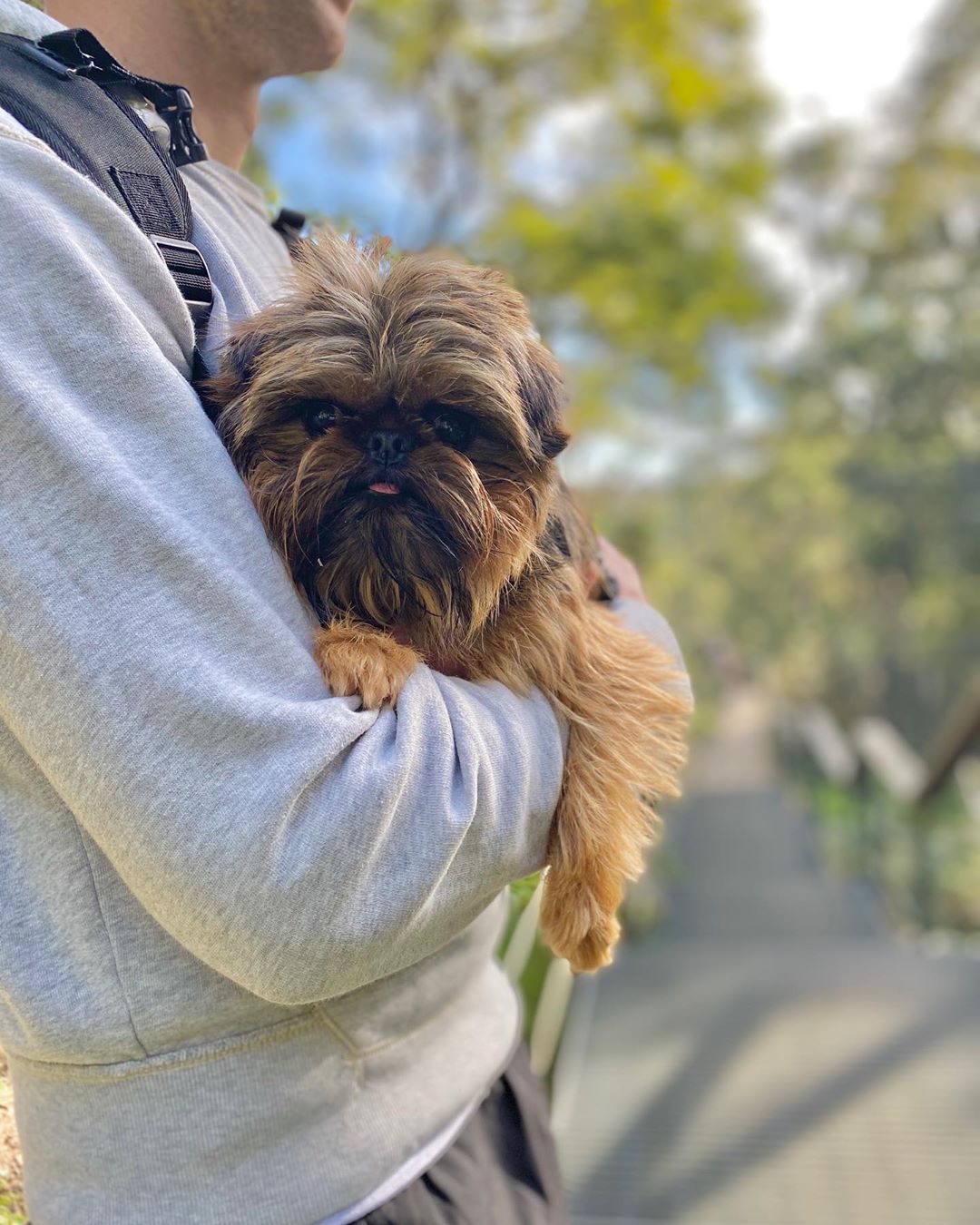
The Brussels Griffon is an ornamental breed. It cannot be called a lap dog, meaning a pretty and docile pet. Griffons are known in Belgium as street shooters: rough and stocky, with a naughty rough coat and “human” expression in the eyes.
The breed standard defines the following parameters: height at the withers – 27-32 cm (for males) and 25-30 cm (for females ; body weight – from 3.5 to 6 kg. “Boys” look stronger and stronger: the gender type is well expressed.
The head of the Brussels Griffon has a rounded shape, looks large about the body. In comparison with the convex forehead, the superciliary arches and the occipital protuberance are inconspicuous. The skull is round and large.
Brussels Griffons have a very short and upturned muzzle. Its length usually does not exceed 1.5-2 cm. The stop is deep: the frontal part abruptly passes into a small bridge of the nose. The short nose is notable for wide nostrils, divided by a furrow, pigmented black. When viewed in profile, the tip of the nose and forehead form a line. When viewed from the front, it can be seen that the eyes and nose of the animal are at the same level. Dry and tight-fitting lips have a dark border. Even though the upper lip completely hides the lower jaw, there are no so-called pockets in the corners of the mouth. The teeth and tongue are not visible when the dog’s mouth is closed. The chin protrudes forward, slightly raised. On the coat of the muzzle, a “mask” stands out, one or two-tone darker than the main color of the coat.
The ears of the Brussels Griffon are small in size, set high on the crown, and at a considerable distance from each other. Located in a semi-standing position with a slight forward inclination. The standard allows ears to be cropped: they become pointed and slightly raised.

The eyes are set wide and in line. They are quite large in size; rounded but not convex. The griffon’s look is inherent in “humanity”, which makes even puppies seem wise from life experience. The eyelids fit tightly, completely hiding the whites of the eyes and the so-called third eyelid. “Decorated” with long eyelashes, which creates the effect of black edging. The preferred color of the iris is brown; the darker the shade, the better. The look is expressive and lively.
The lower jaw of the Brussels Griffon is U-shaped, slightly curved upward, forming an undershot mouth. The incisors are on two parallel lines, and the canines are fairly wide apart. A complete dental formula is required. When the mouth of the dog is closed, the tongue and teeth should be hidden.
The strong neck of the animal does not look heavy, despite the high set and “bulge”. Medium length, with lean muscles.
Brussels griffons are characterized by a square body format: the height of the dog at the withers coincides with the length of the body. Due to the developed bone, it seems that the animal’s chest protrudes forward, like a hussar proudly wearing his uniform. Rounded ribs do not create a “barrel” effect. The withers of the dog are moderately expressed. The long shoulder blades are tightly pressed. The back of the griffons is muscular and strong, passes into the lower back (its line is slightly raised upwards). The croup is sloping downward. The belly is tucked up, the groin is outlined.
The tail of the Brussels Griffon is characterized by a high set. It is carried raised, the tip “looks” at the back, but does not twist and does not touch it. Docking of the tail by 2/3 of its original length is permissible.
The forelimbs are distinguished by relief muscles and strong, well-developed bones. “Carried out” under the body of the animal, placed parallel and at a considerable distance from each other. Elbows tucked tightly under the withers. Steep forearms merge into short pasterns. The griffon’s limbs end in small, round paws with tucked-in toes. Pads and nails pigmented black.
The hind legs are set in such a way that they protrude slightly beyond the ischial tubercles; the angles of the articulations are moderately developed. The strong thighs are notable for their prominent musculature. The hock joint is set low above ground level and merges into a strong hock. Feet are rounded and arched, ending in hard pads and black nails.
Brussels griffons trot. The hind legs provide a powerful push, while the front legs are moderately thrown forward. When moving, the back remains straight and even.\
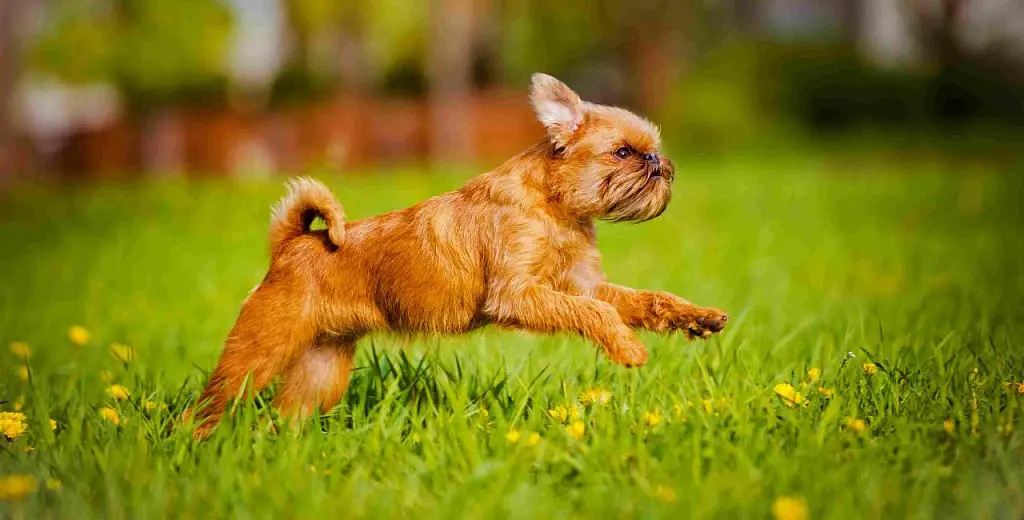
The guard hair is of medium length, thick and wiry – the rougher it feels, the better. Around the eyes of the dog, near the nose, on the cheeks and chin, the hair is longer, forming “vegetation” on the face: eyebrows, sideburns, mustache, and beard. Needs manual trimming.
The Brussels Griffon breed standard provides for the following color options:
- red with a brownish “mask” and dark adornment coat;
- beige with brownish-red or black “mask” and dark decorating coat;
- solid black (gray hair appears in adult dogs).
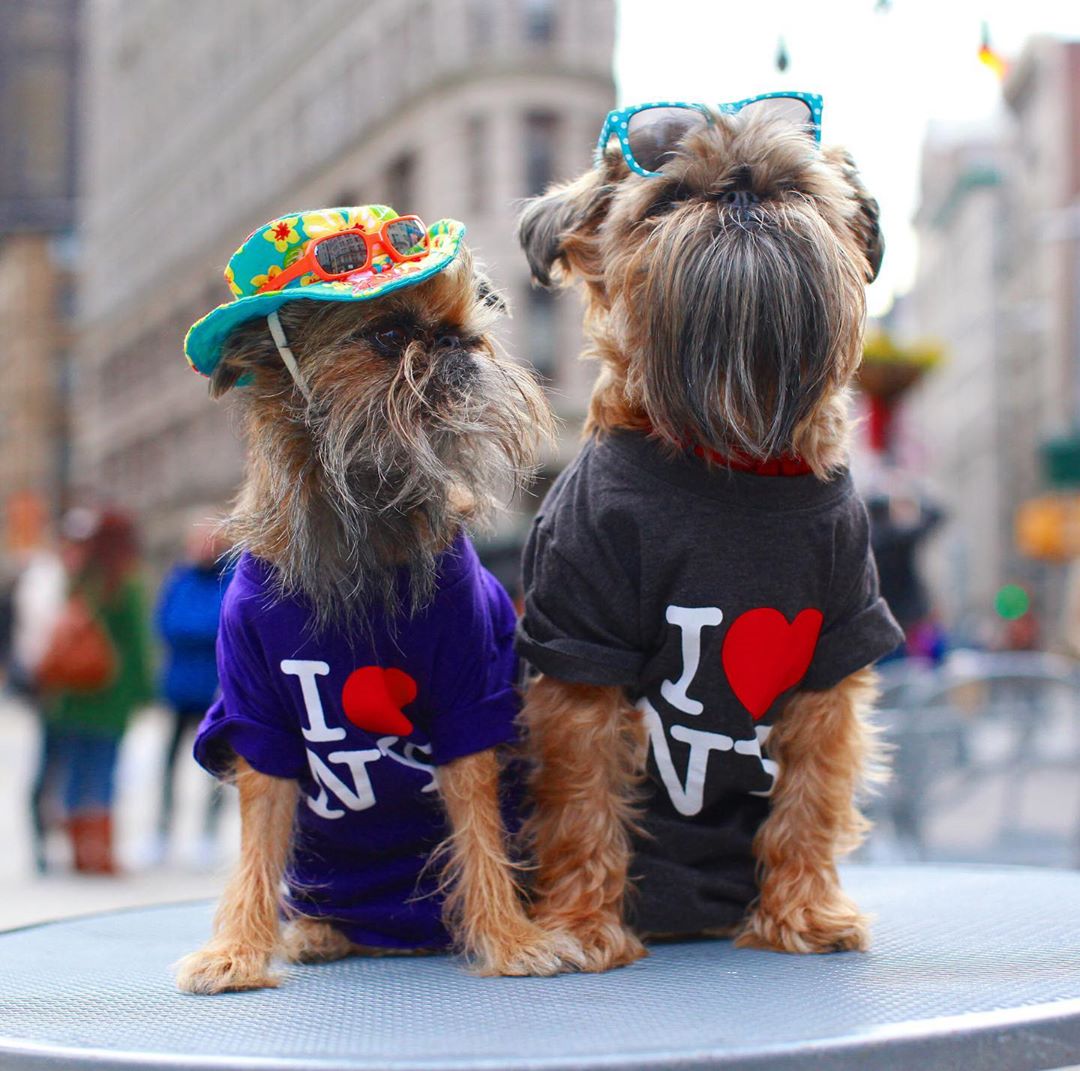
The slightest deviations from the standard are considered defects. Among the common ones are:
- stretched or shortened body format;
- silky and soft coat;
- slanting and/or light eyes;
- lightweight or rough physique;
- pointed and/or drooping muzzle;
- aggressive or cowardly behavior;
- sloppy cut wool;
- a sharp or right angle of the croup;
- hunchback or sagging lower back;
- brown pigmentation of the nails;
- barrel chest;
- flat and/or narrow head;
- the presence of dewclaws;
- low neck;
- undeveloped muscles;
- overweight;
- white guard hair;
- narrow withers and back;
- straight bite.
The disqualifying faults of the breed are as follows:
- partial or absent pigmentation of the eyelids, nose, and lips;
- white spots or “blurs”;
- the brown color of the nose;
- light pigmentation of the nails;
- loosely closed mouth;
- dislocated joints;
- undescended egg-shaped glands
- lameness;
- overshot;
- deafness;
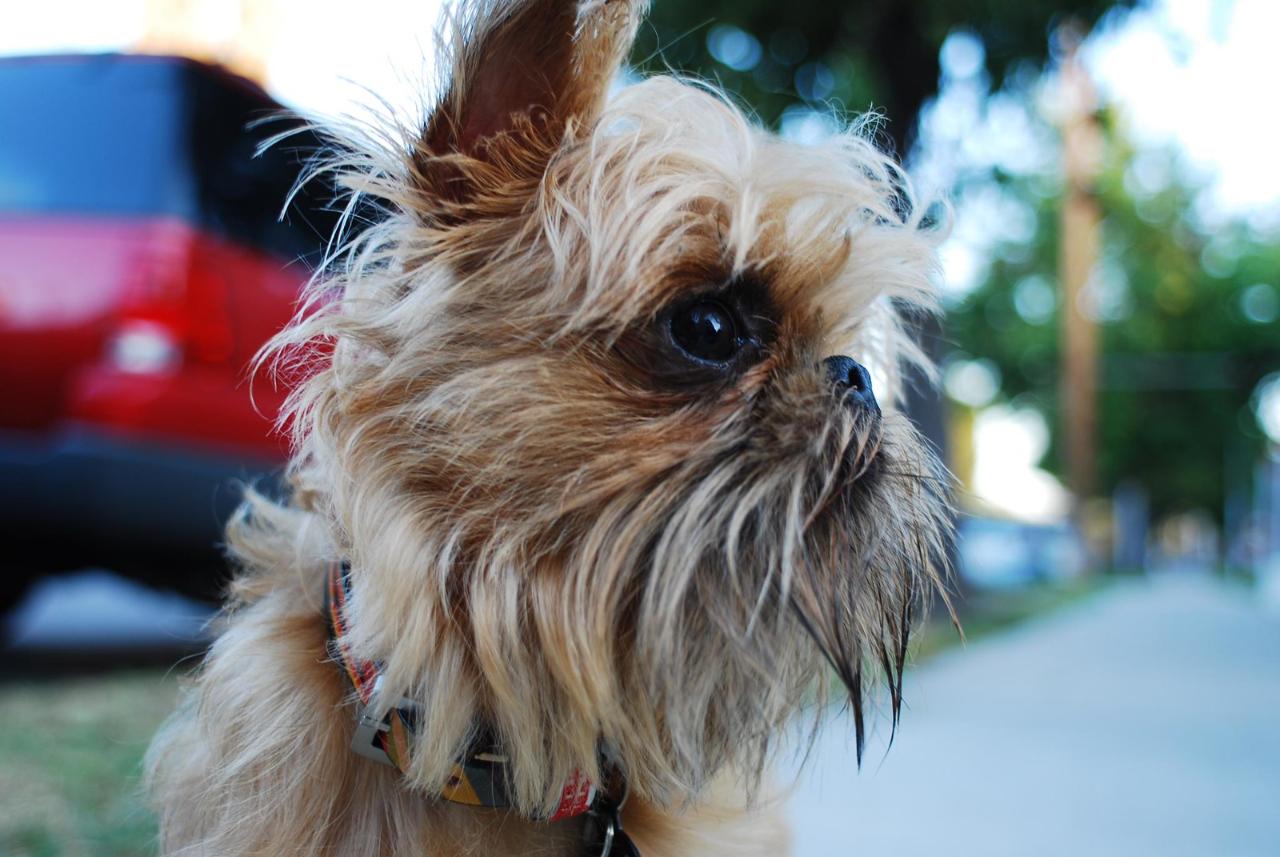
Representatives of the breed look like a stern and unsociable bearded men, but with closer communication with them, it is easy to understand that the first impression is still deceiving. Brussels Griffons are energetic and sociable dogs that love to be the center of attention. You should be careful with the latter: it is easy to raise capricious and demanding pets from these babies who will not leave you alone until they get what they want.
Griffon owners refer to their pets as “tails”. Indeed, animals are accustomed to following the owner on the heels and at the first opportunity to “kiss” him half to death. Four-legged people from Brussels tend to support any, even the most extravagant idea. A spontaneous trip to the riverbank in the early morning? All paws for! An unexpected trip to the ends of the world? Better! No matter how tired and sleepy the “Brussels” maybe, he will not grumble in response to an offer to spend time actively and will find strength for a long-awaited walk.
Living in a large family, the Griffon considers only one person to be his equal. The rest will have to try pretty hard to earn at least minimal trust from the dog. And it’s not even worth talking about selfless love: it can take more than one month to win the heart of an obstinate baby.
Although the Brussels Griffons are confident in themselves, they need the company of the owner and do not put up with loneliness. This breed is not suitable for people who spend a significant portion of their time in the workplace. The “Brussels” will not become the best friend and one who is not accustomed to obligations to a living being. The animal tends to impose its company, which is not to the liking of every person.
There is a widespread belief among beginners that decorative dogs do not need long walks. In the case of the Brussels Griffon, this is not the case: representatives of the breed love to explore the surroundings under the close supervision of the owner. Of course, a half-hour promenade is enough for animals, but if you manage to stay outside as long as possible, there will be no limits to the pet’s happiness! It seems that under the harsh-to-touch fur there is a small motor hidden, which sets the dog in motion, forcing it to frolic in the fresh air.
Despite its modest size, this breed is famous for its protective qualities. A small “bell” will notify the host about the approach of an uninvited guest. Of course, one should not expect zealous protection of property from a griffon, but still, rest assured that a fly will not fly past the vigilant “bearded man” unnoticed.
“Brussels” needs early socialization, otherwise, the dog will show fear or aggression at the sight of strangers. Even properly raised griffons are wary of strangers. A typical breed representative will not wag his tail in vain if people around him sincerely admire him. Instead of loud and joyful barking, the animal will grumble and take a step back. It is unlikely that a stranger will be able to stroke the baby.
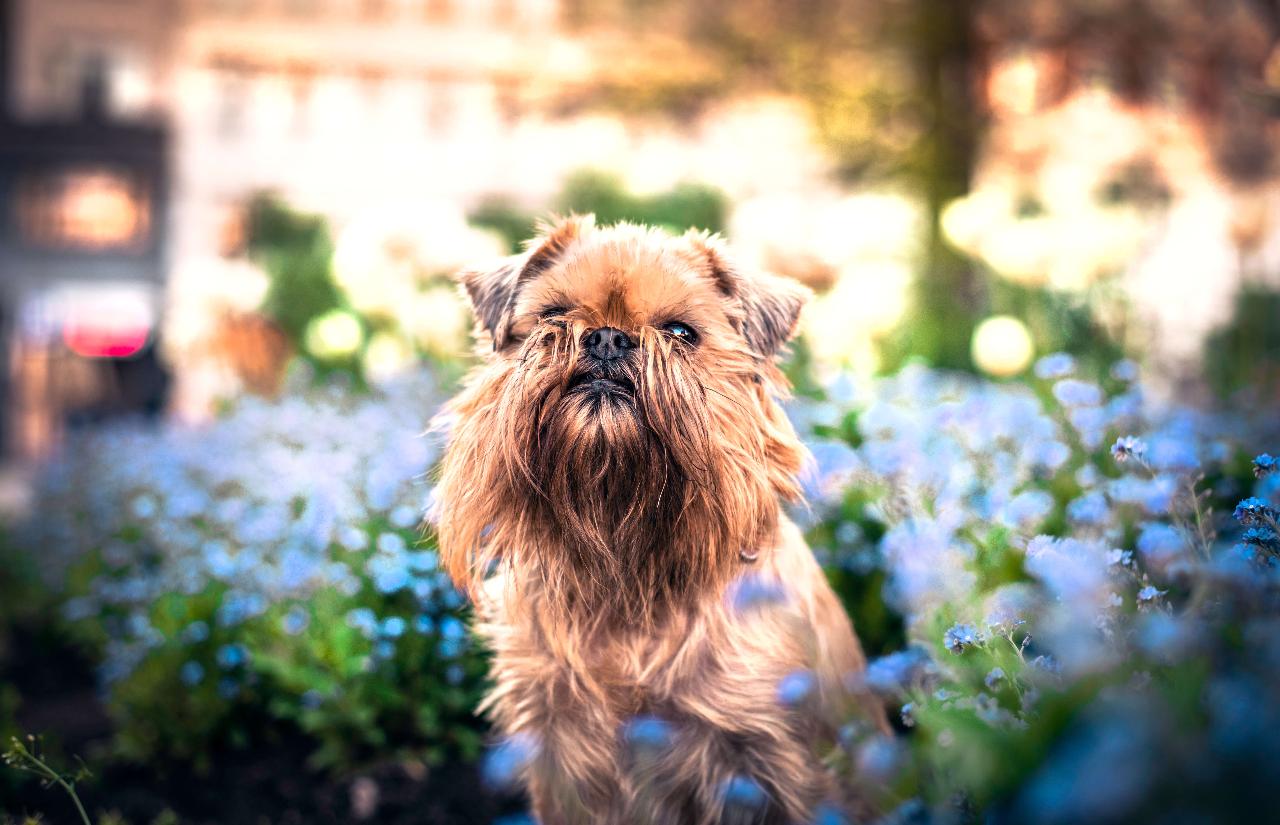
Families with children should consider other breeds. Brussels griffons are not patient with childish games, will not put up with rough jolts, and may even bare their fangs if they see danger in the child’s actions. In addition, these small dogs are quite fragile and require an appropriate attitude towards themselves. Unfortunately, not all children are careful with pets.
Representatives of this breed easily find a common language with their relatives. If you already had a dog in your house before the appearance of the griffon, the Brussels “bearded man” will gladly recognize the authority of an older friend and even begin to copy his habits. However, some kids will still try to take the place of alpha. The owner’s task is to suppress possible aggression. This rule applies to other pets as well: cats, decorative rodents, and birds. The socialized griffon is tolerant of animals, but in any case, he will jealously protect his toys and treats.
Brussels griffons are not suitable for keeping in an aviary – this is a fact. Small pets like a cozy apartment without drafts. Equip your dog with a secluded place, set aside about an hour and a half for a walk every day, get out of town more often – and the Brussels Griffon will be the happiest!
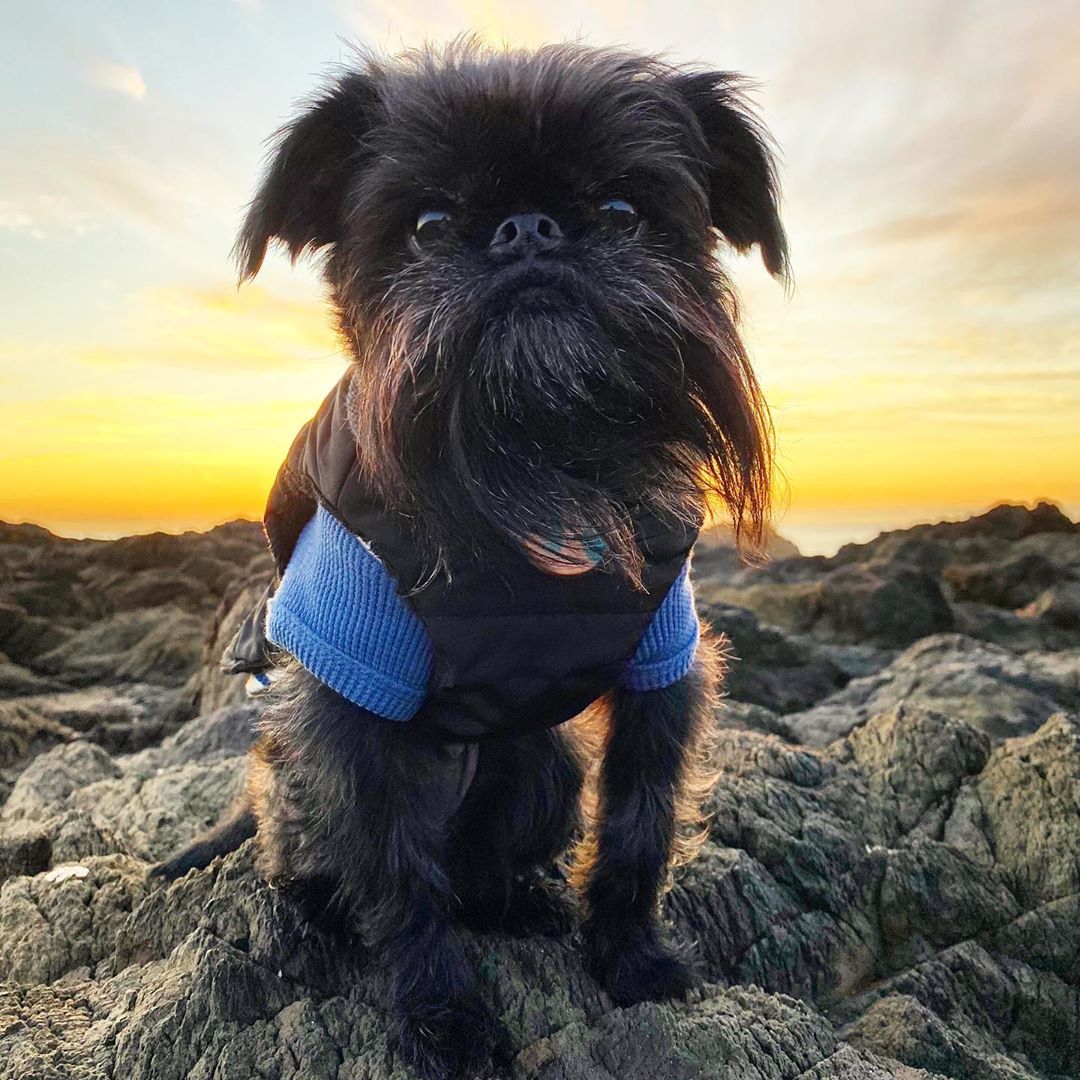
In addition to the appearance of a wise old man, the Brussels Griffon is also remarkable for his inquisitive mind. Even two-month-old puppies can easily understand what they want from them, so their education should be started as early as possible. First, clearly determine the position of the leader: the griffon should not allow the thought that he is the main one in the family. “Brussels” tends to dominate, so this breed is not suitable for people with a gentle disposition.
Although griffons are reputed to be quite intelligent dogs, training them can become difficult. The animal often shows stubbornness and willfulness, so training will take a lot of time and effort. At the same time, the Brussels Griffon is one of the most trained miniature breeds. It is worth starting with the study of the basic commands: “Sit!”, “Lie!”, “Voice!”, “Come to me!”, “Give your paw!” If necessary, you should contact the services of a professional dog handler.
In the process of training, use the main weapons – consistency and patience. Use only positive methods: treats, rewards, or gentle stroking behind your ear. It is not recommended to raise his voice to the dog: after such humiliation, the griffon will not soon tune in to a training mood.
In addition to teams, it is worth using the Brussels Griffon in certain sports – in particular, agility. During the obstacle course, the animal will not only repeat the commands already learned but will also stretch its paws to their fullest. In addition, communication with the owner and four-legged relatives will only benefit.
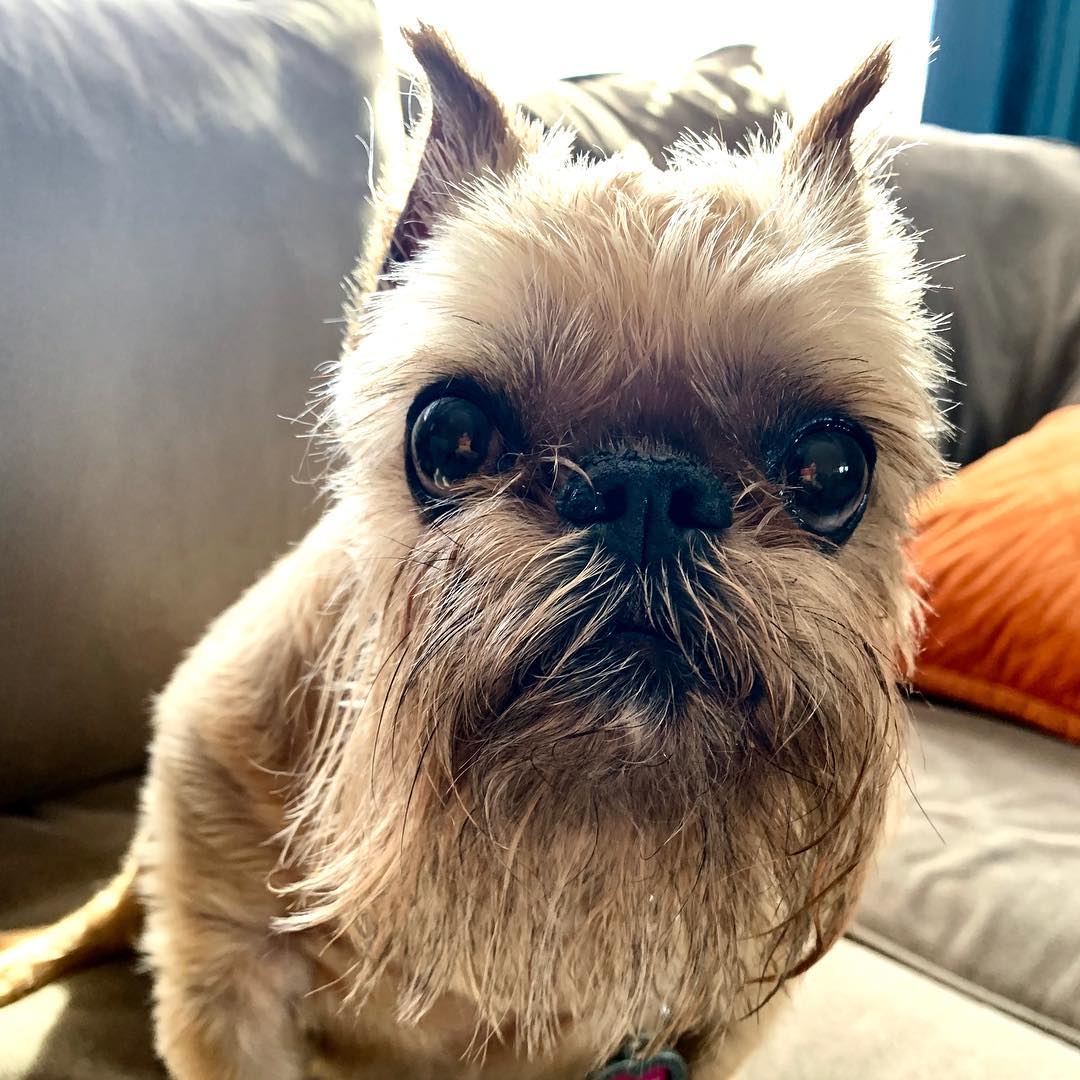
Due to the specific coat, the Brussels Griffons need constant and careful care. The dog should be combed at least once a week (preferably more often) using a thick-toothed comb or furminator. A special “spiked” mitten will do as well: these are sold in pet stores. Sideburns, mustaches, and beards should be combed daily to keep the coat tangle-free and tidy. Representatives of the breed also need regular trimming – plucking hairs. It is advisable to entrust this procedure to a specialist, especially if your pet plans to participate in the exhibition.
Representatives of the breed do not need regular water treatments: this negatively affects the condition of the coat. It is enough to bathe the dog as needed, but not more than twice a month. Pay attention to the composition of the zoo shampoo: it should not contain aggressive substances. Before bathing, dilute the hygiene product with water in a ratio of 1: 3. Rinse off the shampoo thoroughly, especially from the beautifying hairs on the animal’s face. After bathing, it is enough to wipe the griffon’s fur with a towel made of natural material, which absorbs moisture well. Make sure there are no drafts, otherwise the dog may catch a cold. The ideal place to relax after a bath is a dry and warm room.
It is important to know: small skin folds on the face of the Brussels Griffon are a favorable place for the growth of pathogenic bacteria. Be sure to check them after every walk or meal. This way you will avoid forced visits to the veterinary clinic.
The trimming procedure is also necessary for the griffon’s ears: the thick hair in the shells prevents good ventilation. To soften the sulfur and remove it carefully, it is recommended to use agents with a drying effect.
The dog’s eyes should also be examined regularly. Their convex shape contributes to irritation due to long hairs, so the areas of the body above the nose must be carefully trimmed. The hairs are pulled towards the inner corner of the eyes. Remember that abundant discharge is an alarming signal: you need to eliminate the problem as soon as possible, otherwise, the intervention of the veterinarian will be required.
The oral cavity is another favorable breeding ground for bacteria. The owner of the Brussels Griffon should take care of regularly removing plaque from the pet’s teeth. The frequency of the procedure can be reduced if the dog eats dry food: in this case, cleaning is carried out involuntarily. Host intervention is required only once a month. Animals that eat natural food will have to clean their dentition from puppyhood. To do this, you need to purchase a special paste at a pet store. You can “please” the griffon with a fish or meat-flavored hygiene product. Some dog owners recommend rubbing their pets’ teeth with activated charcoal, which slows down the formation of plaque.
The Brussels Griffon is a very active breed, the claws of its representatives most often grind off on their own. Sometimes this does not happen, and the animal begins to experience discomfort. A special nail clipper for small dogs will come to the rescue here. Trim the griffon’s claws carefully, without touching any areas of blood vessels. Do not hurt your pet, otherwise the next time he will do anything just not to be given to you.
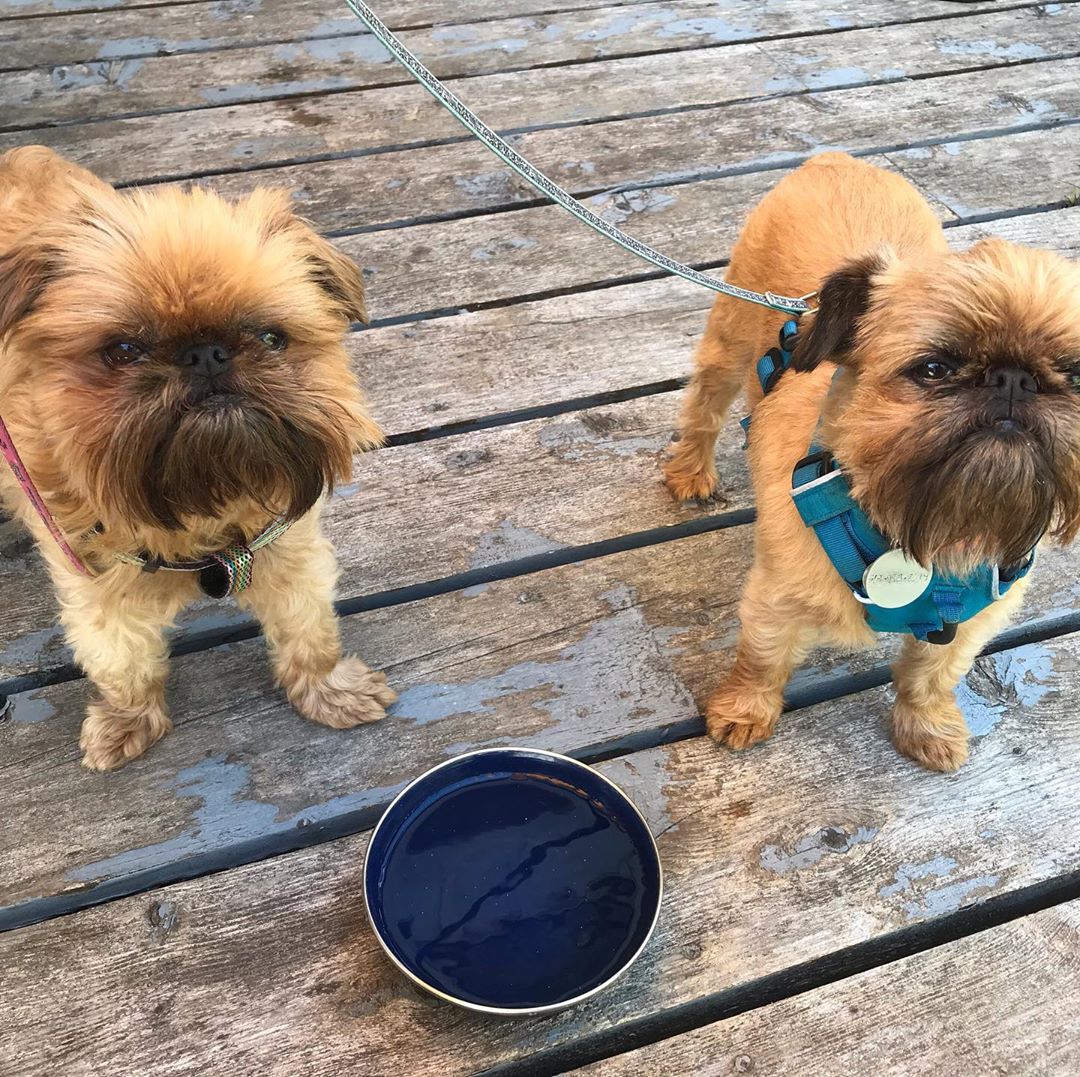
Nutrition is an important consideration in keeping Brussels Griffons. When acquiring a new friend, it is worth consulting with the breeder regarding the dog’s previous diet: it is strongly not recommended to change it drastically. It is necessary to transfer the pet to a new type of food gradually, observing the well-being of the Griffon. The breed often exhibits allergies.
There are two diet options: dry food and natural food. When choosing the first one, you must consult with your veterinarian and carefully read the recommendations on the package. Super-premium or holistic food is ideal. This way of eating will save a lot of time.
The natural diet of the Brussels Griffon should include raw or scalded meat, boiled boneless sea fish, and cereals (oatmeal, buckwheat, rice). Cynologists recommend supplementing the dog’s menu with seasonal fruits and vegetables, low-fat dairy products, and quail eggs. Add a teaspoon of vegetable oil to the main dish once a day.
It is worth excluding:
- spicy, salty, pickled food with spices;
- “Human” drinks (tea, coffee);
- fatty meat (pork, lamb);
- river fish in any form;
- cow’s and mare’s milk;
- carbohydrate foods;
- smoked delicacies;
- seeds with seeds;
- legumes;
- tubular bones;
It is necessary to provide the dog with constant access to clean water. The owners advise using bottled. Infused tap water is also suitable.
In general, Brussels griffons are unpretentious. Although they need three walks a day, you can teach the animal to relieve itself in a specially designated place (for example, on a diaper) and thereby reduce the time of the promenade. Some bearded owners like to dress them in pretty clothes, but in general, this cannot be called a necessity. An exception is a slush: due to its short stature, the griffon can get pretty dirty, so he will need a waterproof jumpsuit.
Having got a little friend, you need to select a secluded corner. Otherwise, the griffon will hide from prying eyes under the bathroom or bed, on the lower shelves of cabinets, and even on open bedside tables. The animal will also hide its “treasures” there: slippers, toys, socks, pencils, pens, and other items that, in its opinion, have lost their value for the owner. Taking a little furry into the house, you will have to accustom yourself to order, if you do not want to lose many things. By the way, for such an amusing habit, the Brussels griffons are often called house-dwellers.
Despite its modest size, the snoring of the Griffon can be compared to the snoring of the English Mastiff. This is due to the flattened muzzle, which makes breathing too loud. For a sound sleep and great well-being in the morning, it is recommended to organize your pet’s private place away from your bedroom.
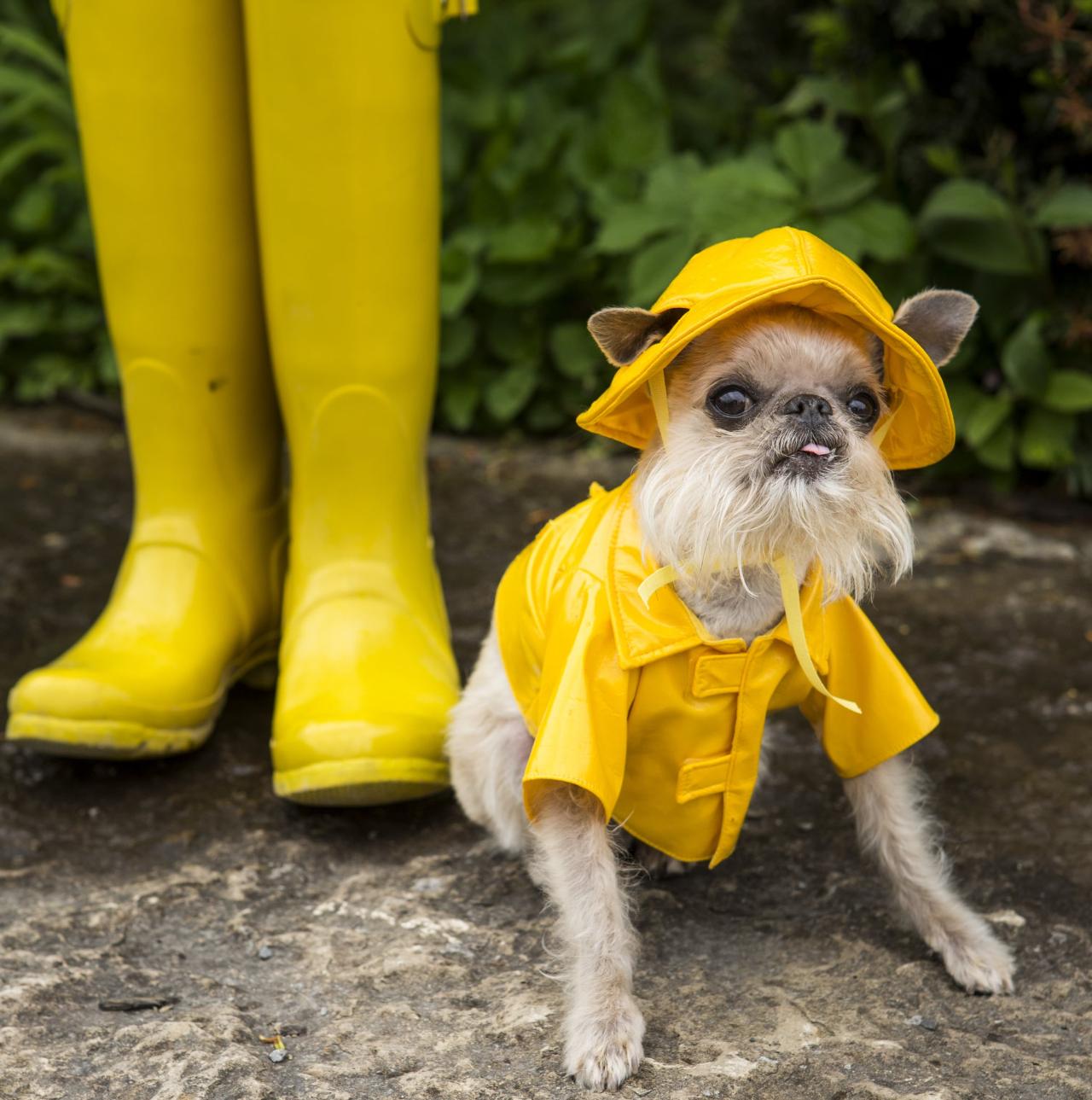
Representatives of the breed are distinguished by strong immunity in relation to viral and colds. At the same time, common pathologies are characteristic of dogs:
- hydrocephalus (dropsy of the brain);
- distichiasis (the presence of extra eyelashes);
- prolapse of eyeballs;
- complications during childbirth;
- a cyst in the spinal cord;
- retinal atrophy;
- Perthes disease;
- narrow nostrils;
Daily walks, age-related feeding regimen, timely vaccinations, treatment against parasites are the keys to the longevity and health of your pet. If you find suspicious symptoms, you must make an appointment with a veterinary clinic.
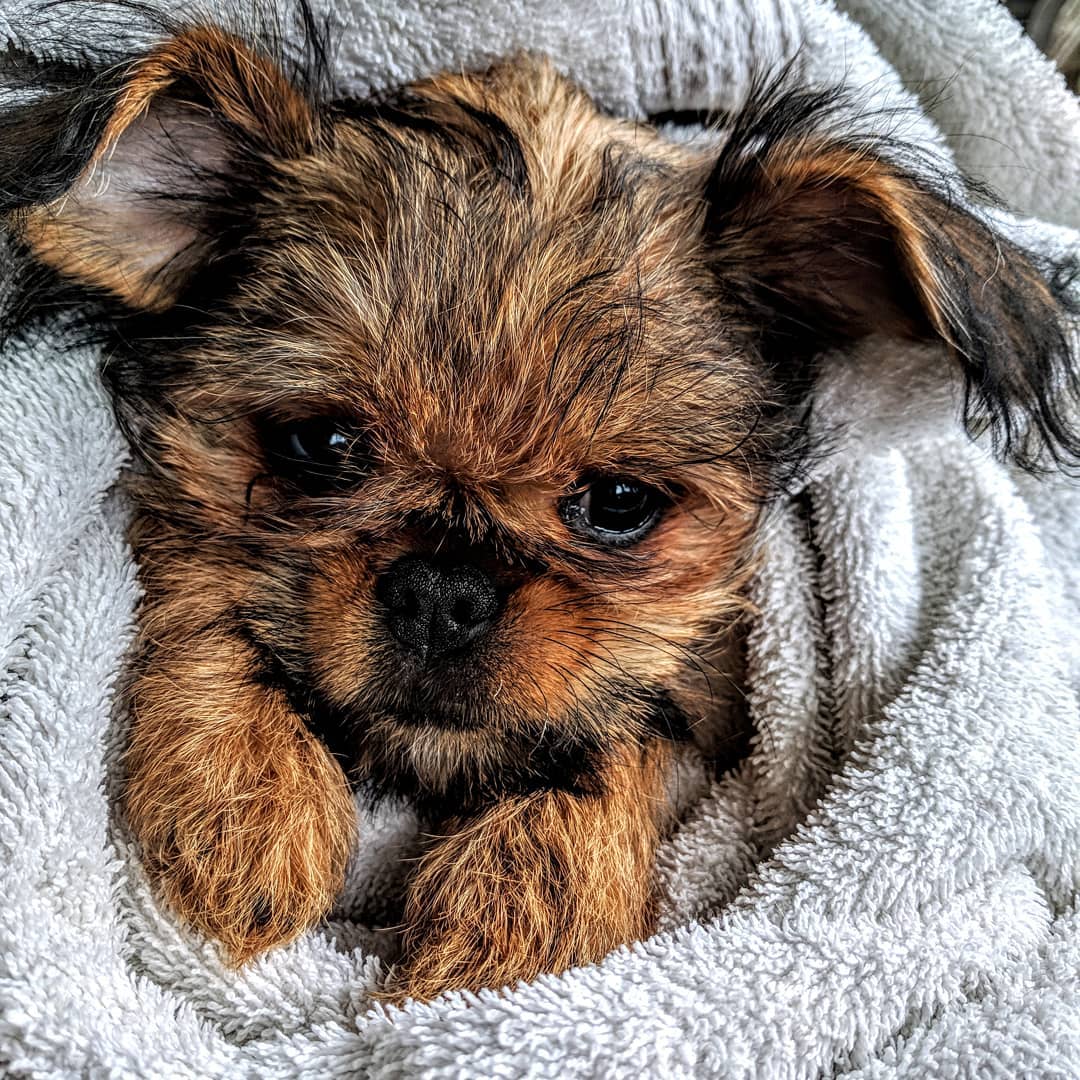
How to choose a puppy?
Before purchasing a Brussels Griffon, it is important to create suitable conditions for keeping your future friend. A lounger, bowls, toys, harness, dog hygiene products – only after purchasing these necessary things should you start looking for a kennel. Breeders who specialize in the breed are mainly located in large cities. If you live on the periphery, think carefully about the way back – already in the company of a four-legged friend.
Once a suitable Brussels Griffon kennel is found, you can start choosing the gender of your puppy. Remember that males are independent and aggressive, while females are obedient and loyal. The latter can create additional discomfort during estrus: while walking with your darling, you will hardly be able to hide from the crowd of four-legged “suitors”.
If you have already decided on the gender of your future pet, it’s time to take a closer look at the candidates! The optimal age for a puppy to buy is 6-8 weeks. Babies who have torn away from their mother early, in most cases grow up weak and unadapted. In addition, the mental state of such a griffon leaves much to be desired: the puppy lacks primary socialization skills.
When choosing a Brussels Griffon, take a close look at the entire litter. If the kids are mostly shy or even aggressive, ask the breeder to introduce you to another dog family. Healthy Brussels people should be curious, playful, and cheerful. It’s easy to check: take a bunch of keys or a rattle in your hand and stretch it towards the puppies. Well-being babies will be immediately attracted by the new sound and smell.
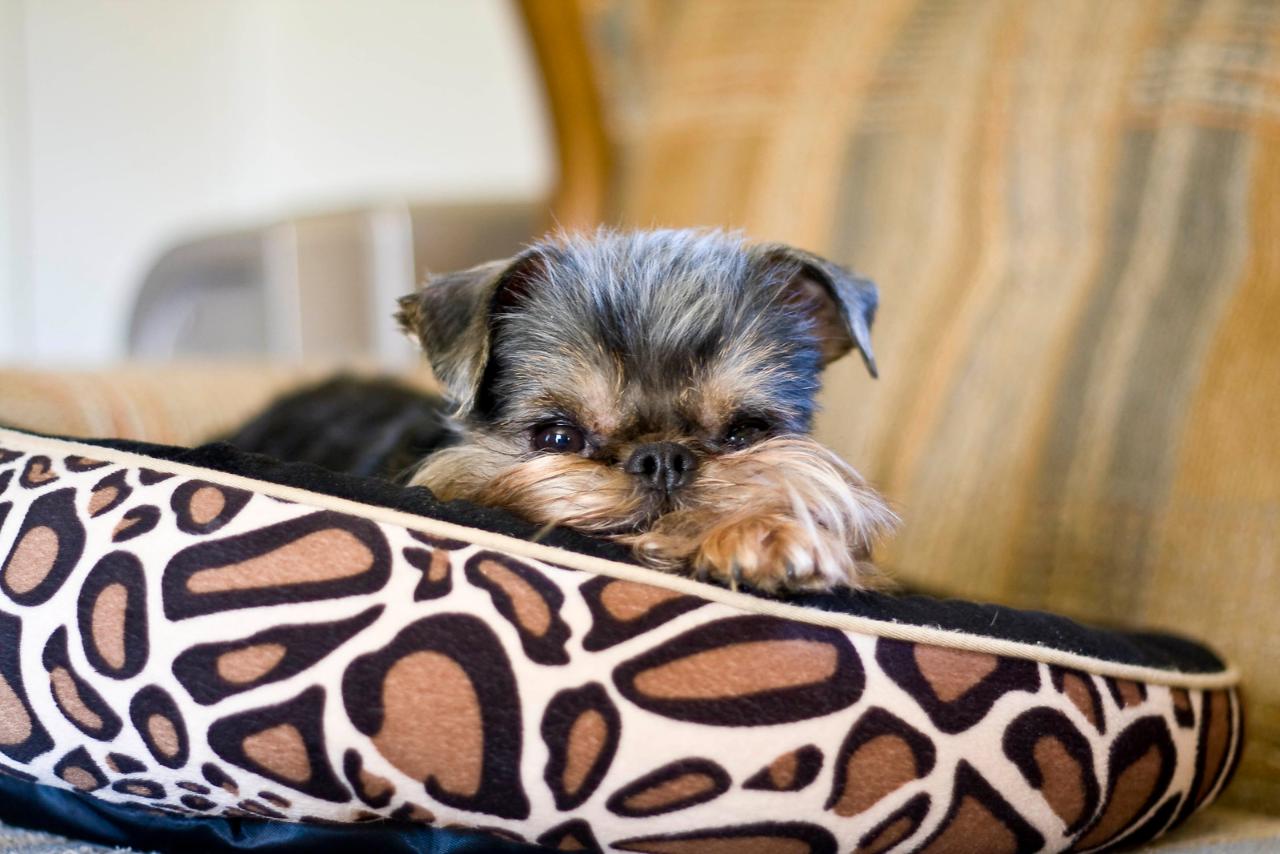
Pay attention to the griffin’s build as well. You should not choose the most well-fed puppy, but the excessive thinness of the animal should also alert you. Give preference to a medium-sized baby, carefully examine him from all sides. The coat should be thick, without bald spots; eyes and ears – clean; paws – intact. A healthy “Brussels” should not cough or sneeze.
The last step on the road to a selfless friendship with Griffon is to obtain documents. A conscientious breeder must provide the buyer with a vaccination certificate for the puppy, his passport, and proof of pedigree. It is worth asking him in more detail about the maintenance of the Brussels Griffons, and especially about the diet of the chosen baby. For a positive adaptation, it is not recommended to drastically change the diet of the puppy.

